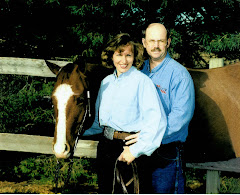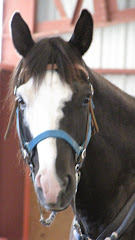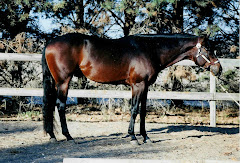June 10, 2009
I stayed up past 11 and I was awake throughout the night. This is very similar to every time I go somewhere in my horse trailer for the first night. Wide awake and excited to get started the next day! But I was still up and going at 6 am, feeding Finny and cleaning his stall. Back to the trailer to eat instant oatmeal for breakfast and have some coffee. I dressed in jeans and my boots, later realizing that I was the only western rider, and not in breeches. Oh well. I had time to check email, work on my blog, and go back out to the barn shortly before 8:30, when the other riders began to arrive with their horses.
The morning started at 9 with a continental breakfast, in the lounge/tack room/sitting area. Introductions around, with me from Nebraska, a few people from Kansas, and even a young lady from Alaska! (She is moving back to Missouri/Kansas area in August). Some of the other riders were locals, as at least 7 were from the Steamboat Springs, CO area. We each told a little about ourselves and what some of our experiences have been. Peggy told us about how she got started in Centered Riding, about meeting and having lessons with Sally Swift, and about her recent trip to Japan to teach a clinic!
Our first order of business was to talk about the Centered Riding Policies and Procedures. We have an Instructor’s Code of Conduct that will be very important for us to read. Centered Riding has a standard of guidelines, that all instructor’s need to give lessons by. Sally believed in Life Long Learning and we have a list of suggested reading as well as learning about other riding disciplines.
We reviewed the Basics of Centered Riding:
Soft Eyes
Breathing
Building Blocks
Centering
Grounding
Clear Intent
CLEAR INTENT: knowing what you want to do and how to get there! Have a plan and direction. Look where you want to go. For me, look for where you want to end your trail maneuver.
CENTERING: finding the neutral pelvis. We had balls in our cupped hands. While tipping our hands back and forth, we found the place in our hands that the balls wouldn’t move. We will work on tipping our pelvis while we are in the saddle, and finding that area where we are not tipped too forward or too backward. Our center is moving while we ride. We need to breathe and re-center as we ride.
Everything in our upper body sits in our pelvis. Our pelvis protects our back. Our back is not a shock absorber. AND neither is a horse’s back.
We talked about habits. We have a life of habits. We have some habits that we may not know that we have until we try to change them! We talked about the dominance factor. Which eye, ear, foot, hand is the dominant one? Which seat bone do you sit on? We need to recognize which may be dominant so that we can become more balanced and equal.
We have “Dynamic Balance”. Balance in Movement. The rider can help balance the horse, depending on how we sit. We need to consider what is functional, and ride for function, not ride a way that looks good only.
“GROUNDING: awareness of our feet on the ground. We have balance receptors in our feet. We are more secure when we feel our whole foot, both on the ground and on the stirrup. Our balance point on our foot is actually further back on our foot than we think. The point is behind the digit joints of the foot.
Enough for the first classroom discussions. After a wonderful lunch, we started our riding sessions. 3 groups of 2 or 3 riders rode for 1 hour and 15 minutes during the afternoon. Before the riding sessions, we talked about saddle fit. We did the “chap stick test”. Laying a chap stick on the saddle, does it roll back or front of lay in the middle of the seat? This is a good way to see if the saddle sits level on the horse’s back.
Our riding groups worked on grounding their feet, hip releases, and walking the knees. For grounding the rider’s feet, we rested our hands on the rider’s ankle, after asking permission to touch them. We learned to breathe and become grounded our self. Tap the rider’s heel, instep, and toe, then find that spot on the bottom of the rider’s foot where the tapping feels different to the rider. That is the spot where the foot should rest in the middle of the stirrup, making the rider grounded. As you ride, be aware of your feet! If we are grounded as riders, our legs feel like they are around the horse and you are feeling your legs reach to the ground.
Riders have 3 springs: hip, knee, and ankle. Our leg joints! We were taught how to release the rider’s hips, allowing the hip angle to open. The hip release allows up to sit on our seat bones correctly. The end of the femur has a ball that sits inside the hip joint. This balls lies to the back of the socked. During the hip release, we roll the ball to the front of the socket. The muscles in the back of the pelvis need time to stretch so we may not feel or see much of the movement - it takes time!
Riding the 2 point position takes the pressure away from the seat bones, while balancing on the foot. Rely on the stirrups to support the weight of the body, not the knees! We practice posting the trot, then 2 pointing then sitting for a few strides and going right up into the posting trot again. While in 2 point position, relax the joints and allow the knees to spring.
While walking, feel the same relaxed, released knee action. Allow the knees to “walk” as the horse is walking. Mimic the horse’s movement. The horse equates relaxation with out-breaths. Breathe. Exhale. Feel the horse relax. As the horse relax, feel, with soft eyes, the relaxation in your legs. Allow the horse’s movement to move the knees.
Remember: take your time. Centered Riding is a journey! Come along and ride this journey with me!
Turning Night to Day
9 years ago







No comments:
Post a Comment